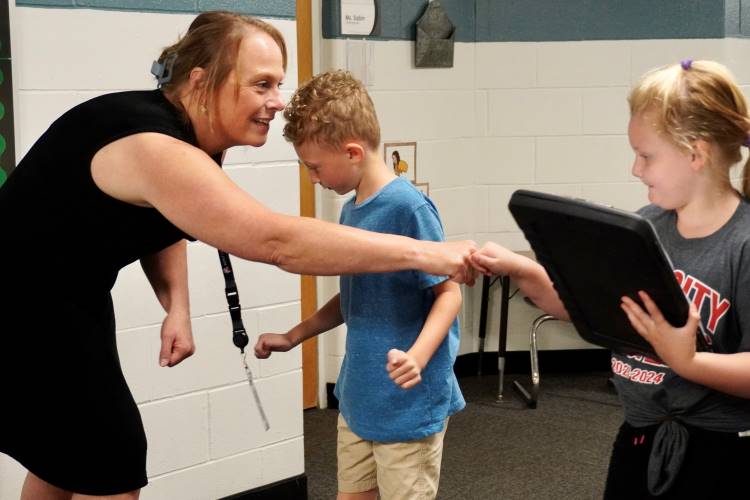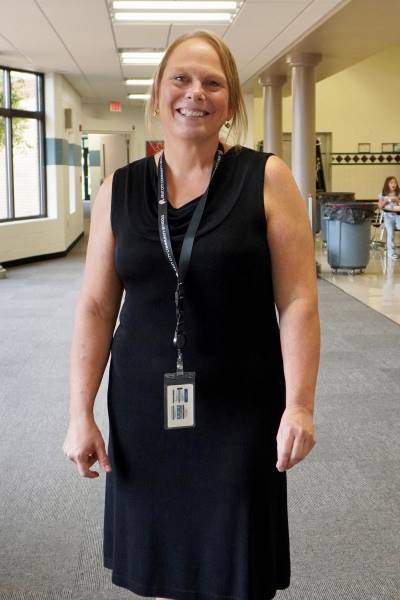Kent City — A tornado drill can be scary for elementary school students, but it can be especially so for the smallest ones — kindergartners who are in their first few months of school. Still, when Kent City Elementary School had its first tornado drill of the year, kindergartner Ella Gonzalez showed unusual courage and helped a classmate who was visibly frightened.
For giving comfort to a friend, Ella received a “praise card” from her teacher, Angela Sabin, to take home and show her parents. The cards are part of a new approach to behavior management in the entire school district.
The new approach is formally called MTSS, short for Multi-Tiered System of Supports, but Director of Student Services Eric Van Treese explains that it’s really about shifting the school’s culture and mindset when it comes to managing student behavior.
“We would like to not be discipline oriented,” he said. “We want to give kids the good stuff.”

“The good stuff” at Kent City Elementary means communicating clear behavioral expectations from the beginning of the year in all school spaces, and celebrating when students demonstrate those behaviors. It’s an approach Van Treese said is proactive instead of reactive.
“What are our proactive strategies in order to prevent the (negative) behavior from occurring in the first place?”
A GREAT Environment
With student input, Kent City staff developed an acronym to establish a common language for creating a positive environment in their schools. GREAT stands for:
- Give and Get Respect
- Responsible and Safe
- Engaged
- Accepting
- Trustworthy
At KCES, teachers and students spent the first 20 days of class talking about what each concept means at an age-appropriate level and modeling positive behaviors that correspond to each one.
Sabin is working with kindergarten students like Ella to make sure they understand what GREAT means for them.
“I… work with students on creating what works best in our classroom for showing ‘GREAT’ … It was powerful to go through each word and provide books and examples of what the words (mean) so all students (can) understand.”
So when a student’s behavior doesn’t meet the expectations discussed at the beginning of school, it’s easy to point to the acronym to reinforce what the positive behavior should be.
“I simply ask for students to ‘show me GREAT’ because we were able to have the time and understanding to know what that means,” Sabin said.
‘It’s like we build up (a student’s) bucket full of praise so when we have to ask (them) to change their behavior, they’re more likely to respond to what we’ve asked them to do.’
— Susan Brummel, MTSS implementation consultant at Kent City Community Schools
Three-Tiered Approach
But what happens when students don’t show GREAT behavior at school? In the new MTSS model, teachers at KCES won’t use traditional discipline like a time out or no recess, but rather a more relational approach to correcting problem behavior long-term.
For example, if students have trouble remembering to raise their hands in class and repeatedly blurt out questions, a teacher may do a quick lesson to all students on what it means to show respect in the classroom and praise students who show the correct behavior.
In the MTSS model, this is a “Tier 1” strategy that helps get all students on board with what it means to be GREAT. For the teacher, this might even mean changing the classroom environment to make it easier for students to show positive behaviors.

But if an individual student consistently struggles to demonstrate the model behavior, they might begin to have what’s called a quick “check-in check-out” meeting with a school staff person each day. This is considered a “Tier 2” intervention in the MTSS model, which is more individualized and specialized.
When a student and staff person have a check-in meeting in the morning, they will talk through a positive behavioral expectation and set a goal for the day. During the day, the student’s teacher will record the student’s behavior so that the student gets a clear picture of whether they’re meeting their goal or not.
In a check-out meeting at the end of the day, the student and staff person will talk through how things went and if the student’s goal was met. Any progress will be met with immediate praise. This daily process will continue until the student consistently demonstrates the positive behavior, and once that happens the student moves out of the Tier 2 intervention.
If a student needs a Tier 3 intervention, Kent City staff will look for more intensive support that will help the student meet their goal. That could involve more frequent check-in check-outs, meeting with a school social worker or, in rare cases, being referred to the school’s special education services if there is an underlying need that’s not being met.
‘Buckets Full of Praise’

Susan Brummel, a Kent City administrator responsible for implementing the MTSS approach at all three school buildings, said that praising students is key to seeing positive outcomes in classrooms.
“The idea is that if you have to correct behavior, (you) have to (follow) that with five instances of praise,” she said.
Teachers at KCES have posters that say “5:1” near their work stations to remind them to praise positive behavior as they see it pop up in their classrooms. So when Sabin saw her student Ella help a classmate during a tornado drill, she let her know that she was being “GREAT.”
It’s not just the consistently well-behaved students who get praise, it’s everyone, Brummel said.
“You might have that student who blurts out, but they might also be very accepting,” she said, referring to the “A” behavioral standard.
Praising positive behavior can directly influence a student’s ability to change their negative behavior.
“It’s like we build up their bucket full of praise, so when we have to ask a student to change their behavior, they’re more likely to respond to what we’ve asked them to do,” she said.
What Does the Data Say?
By definition, a multi-tiered system of supports includes both behavioral and academic aspects. This year, Brummel said Kent City is focusing on the behavior arm of the model because creating a more positive environment is directly correlated to improved academic performance.
“If you were to go after the academic structure first and you don’t have the behavior management pieces, you’re still going to struggle because students don’t know how to manage themselves,” she said.
KCES Principal Pam Thomas agreed.
“I most definitely think that if we can decrease behavior incidents, there will be a direct link to increased student achievement,” she said. “At the most basic level, you will not have those students missing important instruction.”
As the school year progresses and the MTSS system is fully implemented, teachers and staff will be collecting behavioral data to get a full picture of the impact, and so staff can make real-time adjustments.
For example, if a teacher sees a trend of behavior incidents popping up around 1 p.m. every day, he or she might add a quick class break at that time to let students release their energy. Or if administrators notice an uptick in incidents during a specific lunch period, they might remind the students in that period about what GREAT behavior looks like in the cafeteria and praise students who model that behavior.
Principal Thomas is eager to see how MTSS transforms her school’s culture.
“My hope is that through this process we have a school where every student has a sense of belonging, safety and an opportunity to thrive.”
Read more from Kent City:
• ‘Feed the kids’
• Districts bring in emergency coordinator











